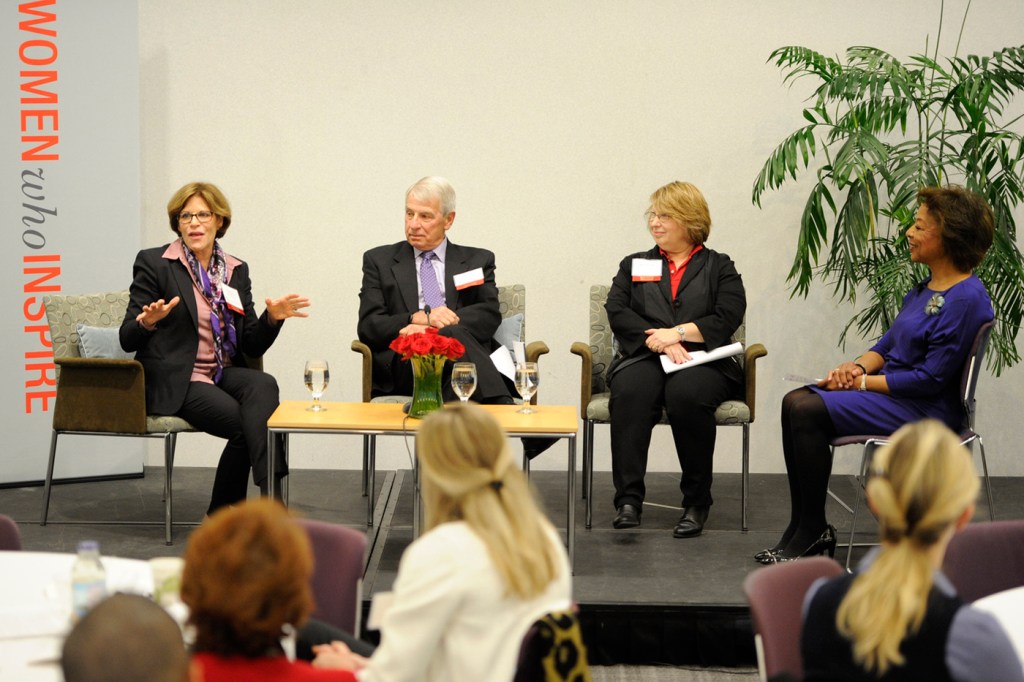Experts provide strategies for joining boards of directors

Wisdom, warmth, and humor flowed on Thursday morning when three distinguished panelists sat down in the Egan Research Center to discuss strategies for women who want to join boards of directors of public, private, and nonprofit companies. Moderated by top executive coach Priscilla H. Douglas, CPS’70, MEd’74, the session helped audience members explore not just what companies look for in board directors but how they can prepare for roles in these positions and assess what openings might be right for them.
“Joining a board is a two-way relationship,” said Michael Jeans, board director of AMICA Insurance and former president and chairman emeritus of New Directions Inc. “It’s about giving as well as receiving. It’s not ‘Here’s what I want’; it’s ‘Here’s what I can bring to the board.’”
The event, part of the Women who Inspire Speaker Series, was titled “Recruiting Beyond the C-Suite: How Do Winning Companies Recruit to Maximize Board Effectiveness?” It was co-hosted by the Boston Club, an organization dedicated to diversifying leadership at Fortune 500 companies, and 2020 Women on Boards, a national nonprofit created to raise the percentage of women on corporate boards to 20 percent by the year 2020.
Douglas—a member of the Corporation at Northeastern and board director of Leader Bank and the Massachusetts Technology Collaborative—guided the panelists through a series of provocative questions addressing the reciprocal relationship that is board membership. Here are some of them.
How do you get on a board?
Networking, the panelists agreed, is one of the primary ways to get on a board—and networking, they stressed, means not sending out numerous emails but developing and maintaining ongoing relationships with everyone from executive recruiters and lawyers to colleagues from past and present jobs.

A panel of board directors addressed a full house at the Egan Research Center in the latest Women Who Inspire Speaker Series event. Photo by Matthew Moodono/Northeastern University
“Eighty percent of board seats are filled through networking,” said Michelle Stacy, board director of iRobot Corporation, Tervis Tumbler, Coravin, and Young Innovations Inc. “Every connection you make is a potential place where you might get a board appointment.”
Indeed, Stacy said, sometimes companies, hearing about you through that network, will come to you “because they see a strategic fit—you have the expertise the company is looking for.” That’s how she came to join the board of iRobot, she said: The company needed her consumer background, which she’d gained in several positions, including as president of Keurig, a $2 billion division of Keurig Green Mountain.
“Consider: What is the expertise strategically, businesswise, that you’re bringing and find the networking bridge that goes in that direction,” she said.
How do you network?
Ellen Richstone, board director of Vioamber, eMagin, Proteck Valuation Services, and Paxeramed, suggested taking your cue from corporate executives themselves.
“Think about it from a governance perspective,” said Richstone, who is the former CEO of Entrepreneurial Resources Group and former chief financial officer for several public and private companies. “Companies go through a complex matrix process in choosing board members: What do we need in global skills, industry expertise, now and going forward?” Then, she said, they look at those currently on the board and do a “gap” analysis—what expertise is missing? Next they develop a “pipeline” of possible candidates. “The pipeline,” she concluded, “comes back to networking.”
What is the work of a board?
While the panelists were careful to stress that every board is different, they noted some generalities regarding commitment: Five to six board meetings a year as well as individual committee meetings, some of which may involve travel, and about 400 pages of material to read before board-director meetings. Preparation is crucial, said Stacy. “You are on your own. At the meeting, you must dive right into discussing the key issues.”
Jeans cited a survey from the National Association of Corporate Directors, noting that board service, on average, is 250 hours per year.
“It’s a job,” said Richstone, adding with a laugh, “but you have no staff. You really have to evaluate the needs and your time.”
Every connection you make is a potential place where you might get a board appointment.
— board director Michelle Stacy
The type of issues boards cover run the gamut. Jeans, in his role on AMICA’s audit committee, underlined the importance of risk management. “I make sure the right questions are asked,” he said. This concerns not only financial aspects, he added, but reputation risk, catastrophic risk, and the risk of losing key talent.
Stacy brought up the importance of succession planning: How will the company move forward as roles in the C-suite—the senior-executive positions—change? “You may be asked as well to spend time with people in the C-suite, to understand their skills,” she said.
How do you prepare to be on a board?
An audience member wondered how she might go about acquiring the skills to serve on a board, given that she was not yet a senior executive. The panelists provided a range of suggestions:
- Serve on the board of a nonprofit or a small private company. There you can learn about decision-making, how to interact with board members, and ways to make a board dynamic. “As a byproduct, someone may know of a corporate board looking for someone with your skills,” said Jeans.
- Serve on an advisory board of a company or an organization.
- Strive in your workplace to reach the highest level of responsibility. If you can’t be a CEO or a chief operating officer, get to the point where you run a division or are a subject matter expert, perhaps a research-and-development or marketing pro.
- Educate yourself by attending learning sessions at the Boston Club and from NACD materials.
Closing the discussion, Jeans provided three key questions to ask yourself in assessing any board position: “Are you learning? Can you have an impact? Are you having fun?”





